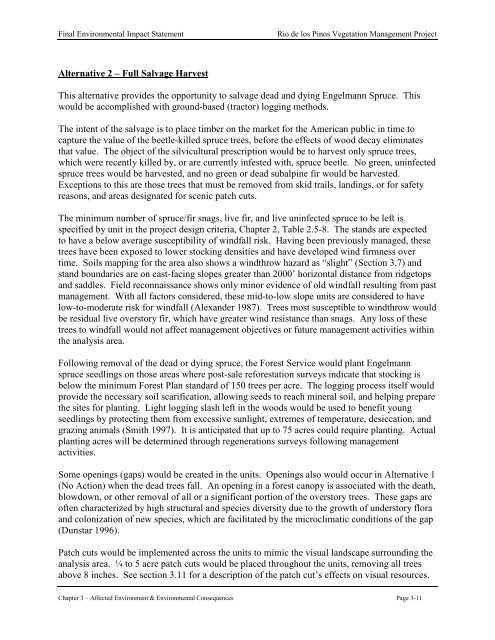Final Environmental Impact Statement Rio de los Pinos Vegetation ...
Final Environmental Impact Statement Rio de los Pinos Vegetation ...
Final Environmental Impact Statement Rio de los Pinos Vegetation ...
Create successful ePaper yourself
Turn your PDF publications into a flip-book with our unique Google optimized e-Paper software.
<strong>Final</strong> <strong>Environmental</strong> <strong>Impact</strong> <strong>Statement</strong> <strong>Rio</strong> <strong>de</strong> <strong>los</strong> <strong>Pinos</strong> <strong>Vegetation</strong> Management Project<br />
Alternative 2 – Full Salvage Harvest<br />
This alternative provi<strong>de</strong>s the opportunity to salvage <strong>de</strong>ad and dying Engelmann Spruce. This<br />
would be accomplished with ground-based (tractor) logging methods.<br />
The intent of the salvage is to place timber on the market for the American public in time to<br />
capture the value of the beetle-killed spruce trees, before the effects of wood <strong>de</strong>cay eliminates<br />
that value. The object of the silvicultural prescription would be to harvest only spruce trees,<br />
which were recently killed by, or are currently infested with, spruce beetle. No green, uninfected<br />
spruce trees would be harvested, and no green or <strong>de</strong>ad subalpine fir would be harvested.<br />
Exceptions to this are those trees that must be removed from skid trails, landings, or for safety<br />
reasons, and areas <strong>de</strong>signated for scenic patch cuts.<br />
The minimum number of spruce/fir snags, live fir, and live uninfected spruce to be left is<br />
specified by unit in the project <strong>de</strong>sign criteria, Chapter 2, Table 2.5-8. The stands are expected<br />
to have a below average susceptibility of windfall risk. Having been previously managed, these<br />
trees have been exposed to lower stocking <strong>de</strong>nsities and have <strong>de</strong>veloped wind firmness over<br />
time. Soils mapping for the area also shows a windthrow hazard as “slight” (Section 3.7) and<br />
stand boundaries are on east-facing slopes greater than 2000’ horizontal distance from ridgetops<br />
and saddles. Field reconnaissance shows only minor evi<strong>de</strong>nce of old windfall resulting from past<br />
management. With all factors consi<strong>de</strong>red, these mid-to-low slope units are consi<strong>de</strong>red to have<br />
low-to-mo<strong>de</strong>rate risk for windfall (Alexan<strong>de</strong>r 1987). Trees most susceptible to windthrow would<br />
be residual live overstory fir, which have greater wind resistance than snags. Any <strong>los</strong>s of these<br />
trees to windfall would not affect management objectives or future management activities within<br />
the analysis area.<br />
Following removal of the <strong>de</strong>ad or dying spruce, the Forest Service would plant Engelmann<br />
spruce seedlings on those areas where post-sale reforestation surveys indicate that stocking is<br />
below the minimum Forest Plan standard of 150 trees per acre. The logging process itself would<br />
provi<strong>de</strong> the necessary soil scarification, allowing seeds to reach mineral soil, and helping prepare<br />
the sites for planting. Light logging slash left in the woods would be used to benefit young<br />
seedlings by protecting them from excessive sunlight, extremes of temperature, <strong>de</strong>siccation, and<br />
grazing animals (Smith 1997). It is anticipated that up to 75 acres could require planting. Actual<br />
planting acres will be <strong>de</strong>termined through regenerations surveys following management<br />
activities.<br />
Some openings (gaps) would be created in the units. Openings also would occur in Alternative 1<br />
(No Action) when the <strong>de</strong>ad trees fall. An opening in a forest canopy is associated with the <strong>de</strong>ath,<br />
blowdown, or other removal of all or a significant portion of the overstory trees. These gaps are<br />
often characterized by high structural and species diversity due to the growth of un<strong>de</strong>rstory flora<br />
and colonization of new species, which are facilitated by the microclimatic conditions of the gap<br />
(Dunstar 1996).<br />
Patch cuts would be implemented across the units to mimic the visual landscape surrounding the<br />
analysis area. ¼ to 5 acre patch cuts would be placed throughout the units, removing all trees<br />
above 8 inches. See section 3.11 for a <strong>de</strong>scription of the patch cut’s effects on visual resources.<br />
Chapter 3 – Affected Environment & <strong>Environmental</strong> Consequences Page 3-11
















